First time I saw Kathleen Nowak Tucci’s jewelry was at Judith Kinghorn’s booth at the Philadelphia Museum of Art Craft Show. One of Judith’s brooches was clipped to an insane multi-layered rubber necklace. What is this? I asked. They told me it was made from the inner tubes of a Harley Davidson.
It was the most unlikely combination: Harley tires with high-karat gold flower. But the matte black made the gold pop, a flower sprouting from foliage noir. I was already a fan of Judith’s work but this collaboration made me see another side of her. And it put Kathleen on my radar.
I got Judith’s assistant to act as a model that day and took this image.
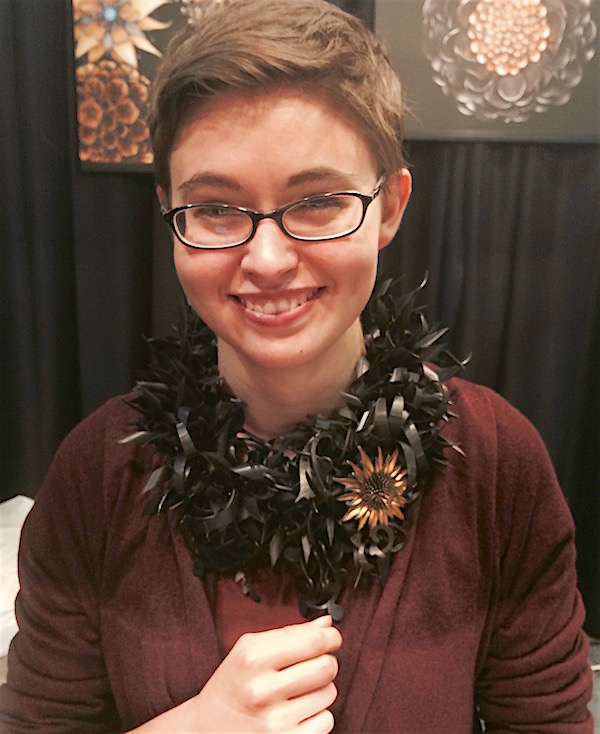
Later, I Googled Kathleen and was surprised to find images of runway models draped with her rubber jewelry. Now I was really intrigued. Her jewelry was featured on the cover of Vogue Italia in 2010 and it took off from there. Her earrings start at $80-$100 retail and her necklaces sell for as much as $3,500, and there is nothing precious about them.
Kathleen is living proof that there’s a thriving market for art jewelry, and we can all learn a thing or two from her about how to reach it. She is as creative, daring and innovative about marketing as she is about designing and making jewelry.
Recently, I got a chance to talk to Kathleen about her work for a feature on recycled jewelry I wrote for Lapidary Journal: Jewelry Artist (on newsstands now). Here are some outtakes from that interview.
What I noticed first about that collaboration with Judith Kinghorn was no visible metal in your necklace, just layers of rubber with a life of its own.
There aren’t many jump rings in that piece. One of the challenges of working with that material was finding ways to connect rubber directly to rubber. I’m very analytical in what I do. I thought a long time about how to make this the easiest, most elegant way.
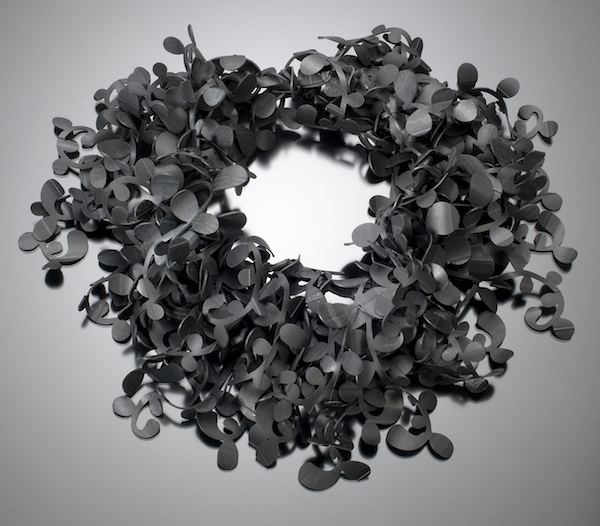
Where do you get your material?
Originally I got it from a local bike shop. I was looking for thin rubber sheeting and finally found it in the blown-out inner tubes this shop was throwing away. After two or three years, I wanted more substantial rubber and I found it at a Harley Davidson shop.
What do you love about working with inner tubes, besides the fact that you’re getting them free?
I still have to clean and buff them up. Inner-tube rubber is flexible and never heavy, no matter how many layers I add. But I love it because it’s so inexpensive, I can experiment freely without thinking, omigosh, this is so precious, I have to be careful. Sometimes I feel like that when I’m working with silver and gemstones. My studio is full of experiments that have failed.
Inner tubes have an interesting texture but they’re so easy to manipulate. I can use scissors, I can use a die cutter. The material allows me to make art jewelry with limited tools. There’s something nice about that. I love tools, but I can make incredible things with just scissors.
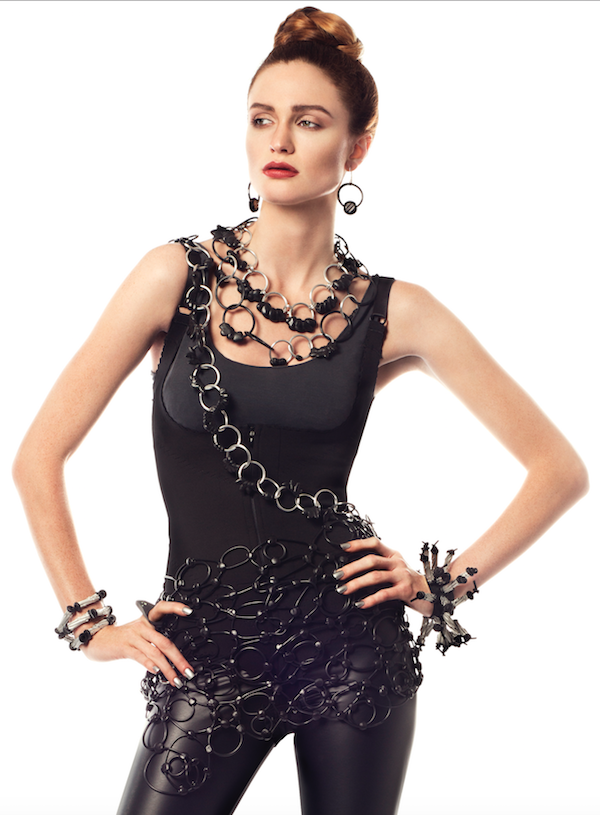
A couple years ago, you introduced a new recycled material. You went from black rubber to Nespresso pods, which are an explosion of color.
I was starving for color! Black is great to work in because you can’t get away with bad design. But I had restricted myself to nothing but black for so long. Then I visited a girlfriend and saw the Nespresso pods for the first time. They’re made of anodized aluminum and the colors are so beautiful. They looked like candies on her counter. I said, What are those?! They were coffee capsules. She was just throwing them away, so I got her to save some for me and I started to play around with them.

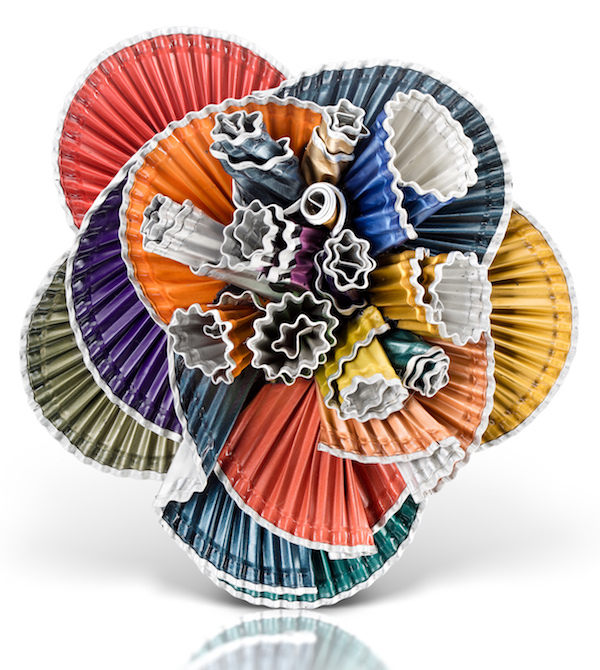
Your jewelry really does look like candy sometimes. It definitely doesn’t look like coffee pods. How long did it take you to figure out how to transform them?
I spent a year experimenting before I could figure out a good way to integrate the rubber and the Nespresso – first, because I’m really big on craftsmanship and, second, because I sell so much I never want to see a piece back for repair! Now I never go anywhere without a few pods in my bag, and my favorite pliers. Whenever I have a few minutes to kill, I pull them out and start crimping.
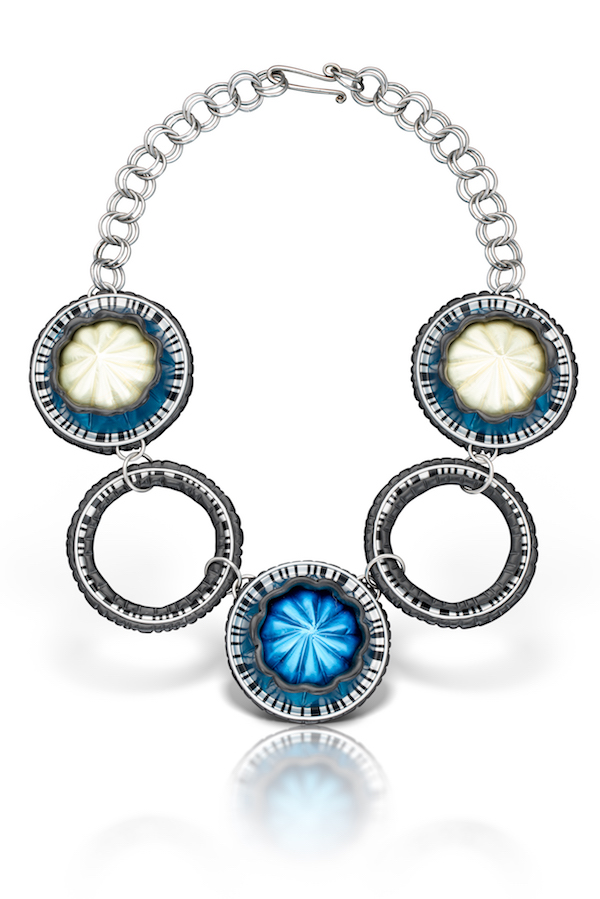
Your studio is in Alabama. How did your jewelry end up on the runway and fashion magazines?
I started showing my work in NYC during Fashion Week and began using models for shoots. That is the way you sell jewelry in fashion. I started thinking it would be really cool if I could make a piece of clothing for my model to wear. The rubber skirts and body art started off as just a way to entertain myself.

So the model shoots to promote the jewelry ended up inspiring the jewelry?
Yes. And then the stylists I was working with started using my jewelry for magazine shoots. A shoot like that is a collaborative effort, mainly between the artist, photographer and model. But there are about nine people on the set. It’s a huge production.
That must get expensive.
It does. But it’s one of the best investments I ever made.
It was a brilliant move. The models present your jewelry in a way product shots never could. Jewelry made from Harley tires is kind of badass. The models make it edgy and elegant at once.
It definitely worked. I’m not showing in New York right now because my career kind of took off, and I don’t have to. I couldn’t fill all the orders and it started to get stressful to reproduce. A lot of boutique and galleries still carry my work.
Who actually buys and wears your jewelry?
My customer demographic is interesting. I used to think it was a little younger, but I think it’s mainly an affluent, over-50 woman who wants to be seen. You don’t wear my jewelry and not expect someone to ask you about it. You’re going to be noticed.
What advice would you offer artists and designers just getting established?
Be persistent. That’s big. And if people in your circle, or the area where you live, don’t particularly like what you’re doing? There’s a big world out there. You just have to find your little part to do well. I live in a small town in Alabama. It’s not my market.
Find more jewelry by Kathleen Nowak Tucci on her website.
